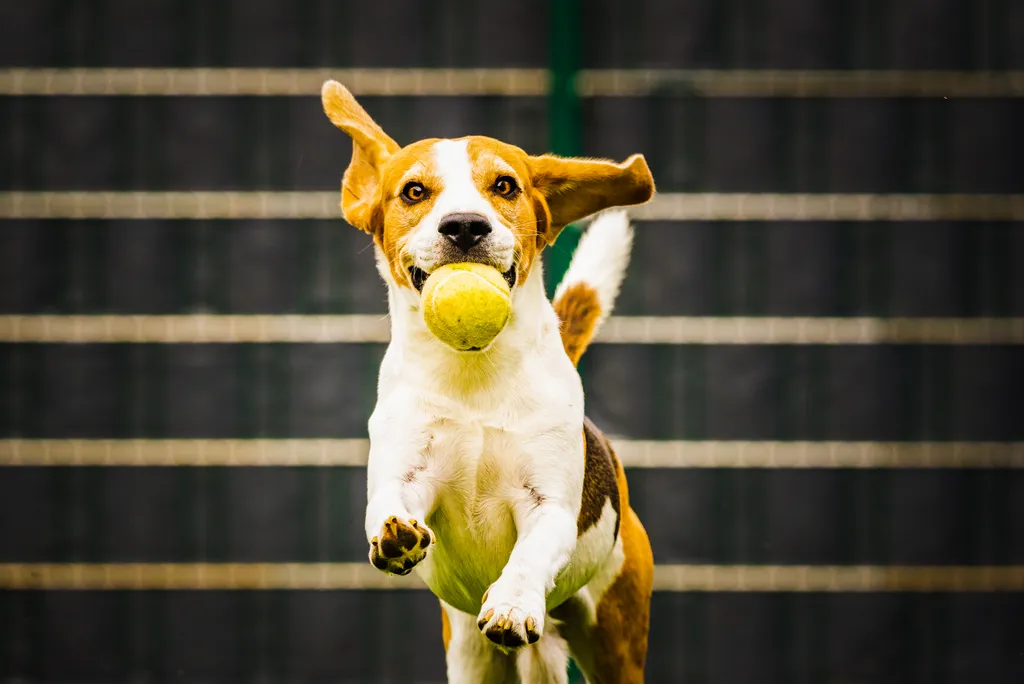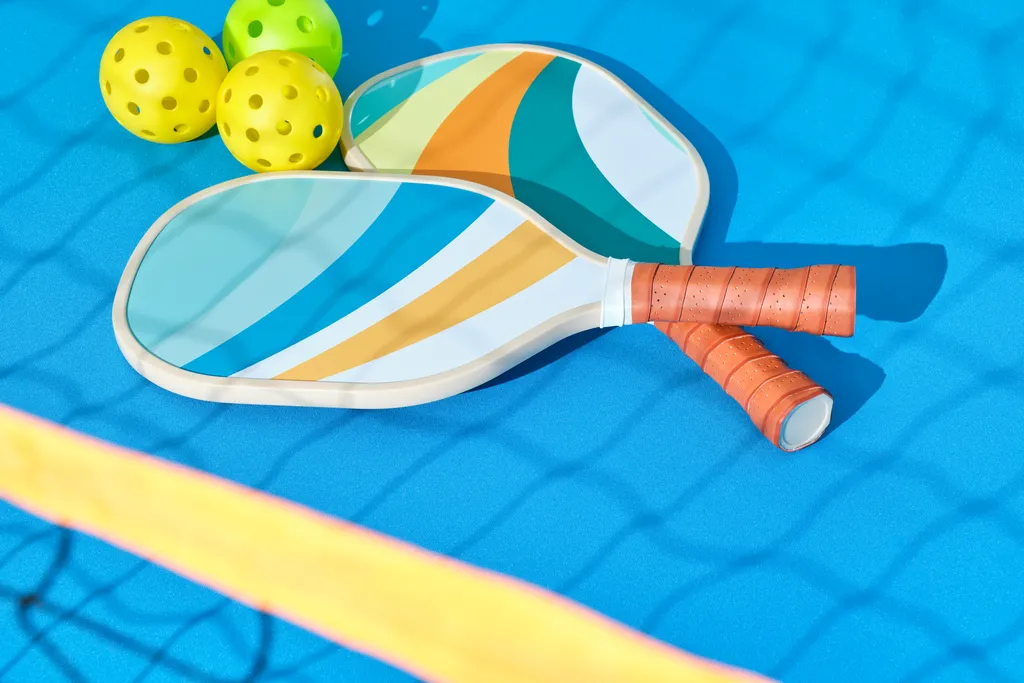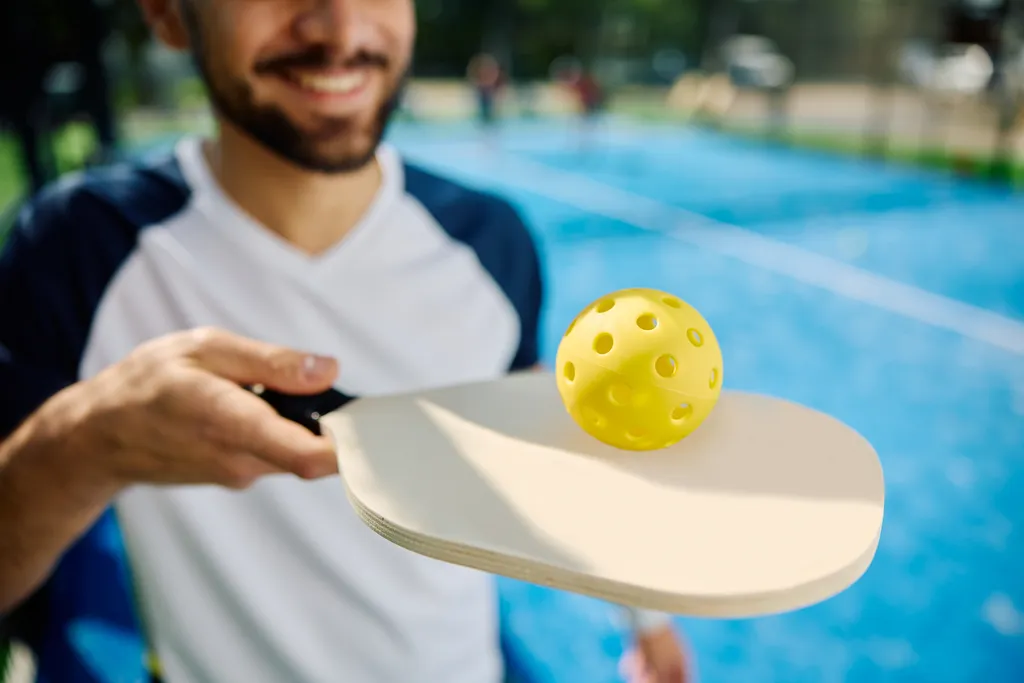It was a great afternoon when I discovered tennis. I had no idea that this chance meeting would take me to a world where dog pickles control the shooting zone, and games are everything. “Why is it called pickleball?” I wondered as I watched players quickly cross the volley zone and swing their paddles perfectly along the line. This odd name has a fascinating background often mentioned during competition bounces.
Pickleball originated in the US in the mid-1960s. It combines tennis, badminton, and ping-pong. The sport has become popular, and now singles and teams can compete. Shot zone is crucial to the game. Players plan their shots here.
Pickles, a family dog, used to chase errant balls during pickleball matches, hence the name. The waffle ball game, named after this joyful dog, relied on him. The games were lively. Discover the intriguing origins of “pickleball.” In this game, players struck the ball back and forth in the volley zone until it bounced.
Bringing to light the history of pickleball
Pickleball is a popular tennis-ping-pong combination. Its distinctive name is raising its appeal. Pickleball players hit the ball over the net and into the return zone with paddles. Play alone or with others. Want to know why “pickleball” is called that? Its name comprises three sources. “Volley zone,” derives from the court’s pre-launch striking area. “Player,” in the second part, means gamers.
Lastly, “Joel” derives from the individual who popularized the sport. Next time you play pickleball, remember: Wiffle ball, a unique game enjoyed for decades, has a weird name. Let’s investigate. Wiggle Ball is popular. It began as an outdoor game and is now a popular sport. Playing wiffleball is enjoyable and fast, like pickleball. Serving in waffle ball can improve your game, regardless of experience.
Three Friends Come Up with an Idea
Friends Joel Pritchard, Bill Bell, and Barney McCallum devised pickleball. While playing backyard volleyball, they debated. This fast-paced game appealed to all ages and abilities. Hitting the ball over the net into the opposite team’s court earns points. Play pickleball alone or with friends. The game aims to outscore the other team. These Bainbridge Island, Washington, men wanted to do something fun with their families in the summer of 1965.
They built pickleball courts and taught family and friends. The pickle boat was their favorite hangout and entertaining experience. The crew had no clue that their brainstorming session would create pickleball, a new sport. Its regulations are similar to those of volleyball and tennis; both beginners and pros can play.
With limited resources, Pritchard, Bell, and McCallum played pickleball on Pritchard’s garden court. They used improvised gear, badminton, tennis, and ping pong rules to play volleyball. The team scored well, and everyone contributed. We wanted to build a game for all ages and skill levels. A team game featuring scoring and volleys was required.
How Pickleball Came to Be?
The buddies thought they had uncovered something important while playing their new game on that awful day. As they competed, the score rose as each squad strove to win. They had no idea their game would be played worldwide. Due to additional participants on both sides, their server needed to be improved.
One concrete area was where the team played pickle. Everyone was competing for points. Everyone enjoyed the game because the ball bounced wonderfully. The server started and set the mood for the match. Pickles, one of their dogs, eagerly chased the ball, scoring a point for their team. The word “pickleball” emerged from Pickles’ foolish antics instantly. This thrilling sport is great for teamwork on the court. Whether serving or receiving, pickleball is enjoyable and demanding for everyone.
So began pickleball. Both teams serve and compete against each other in this sport. Pickleball has developed from a backyard game on Bainbridge Island to a global phenomenon.
How did the name “Pickleball” Come to be?
Many suggestions have come from people who are wondering where “pickleball” comes from. The origins of this sport are still unknown, but many are inquisitive. Some believe it was created by a group of buddies looking for a new amusing game.
Some consider the combination of game pieces a lucky break. No matter its origin, pickleball became popular fast, and both sides enjoyed it. Let’s examine some of the most prominent theories regarding how pickleball earned its name.
Pickles, the Dog Who Chases Balls
Pickleball may have been named after a dog named Pickles, who played with people. According to this anecdote, the Pritchard family played tennis on their estate with Pickles. If they served loose balls, Pickles eagerly retrieved them during games. Pickles was always available. The dog’s play inspired the “pickleball” moniker.
How Rowing Terms Affect Things?
Another theory is that rowing language inspired the game’s name. A “pickle boat” is a rowing boat with extra rowers who weren’t placed elsewhere. Some believe “pickleball” comes from “serving” because it combines tennis, badminton, and ping-pong.
These theories are intriguing, but pickleball’s origins must be determined. Regardless of your age, pickleball is designed to be enjoyable and thrilling. We may never know why we serve pickles.
Regardless of its origin, “pickleball” is popular globally because it’s easy to learn and fun to play. Pickleball is fun for all and brings people together. Its fast-paced, attractive games attract players of all ages and skill levels.

Pickles the Dog’s Interesting Story
Pickles the Dog: The Best Ball Thief Ever
In the early days of pickleball, a family dog named Pickles got into a lot of trouble and accidentally gave the game its strange name. Pickles often ran off with loose balls while his family played baseball in the backyard.
“Pickles’ Ball” changes to “Pickleball”
Pickles’ family and friends often criticized how he would grab the ball and run away. They began to joke about it by calling it “Pickles’ ball,” referring to the dog’s stolen actions. Over time, this fun conversation stuck, and when they were thinking of a name for their new game, they chose to honor their beloved dog.
So, the name “pickleball” was created, which will always remind people of how fun the sport is and how dogs go well with it.
How Pickleball’s Name Will Live On
The story of how pickleball got its name shows how history can be changed by events that no one expected. What began as a funny story about a dog taking balls became a sweet tradition that has lived on for decades.
Pickleball is becoming more and more popular all over the world right now. Its unique name makes people think of Pickles’ naughty adventures all the time and adds to the fun of this already popular sport.
So the next time you play pickleball or hear someone talking about it, remember that it all started with a playful dog named Pickles, who made history in a way he didn’t even know.
Pickleball’s History and How It Came to Be?
Mixing of Different Sports
Recently, pickleball has become popular. Sports were combined to make it. It was designed for all ages and skill levels. The creators aimed to develop a sport everyone could enjoy by merging tennis, badminton, and table tennis.
The original equipment
Early pickleball gear was considerably different. First, wooden paddles resembled ping-pong paddles but were larger. The waffle-shaped plastic ball has holes. These paddle-ball combinations made the game distinctive.
Change and Standardization
Pickleball changed as it gained popularity, and more people played it. Plastic paddles were utilized instead of wooden ones for better gameplay. The plastic ball with holes became smoother, easier to control, and more consistent.
Material changes led to more uniform rules. Pickleball, once played in varied-sized improvised courts, now follows international court standards. Standardization allows players from different places to compete equally.
Critical Moments in Pickleball’s Growth
First Known Tournament: Tukwila Park, 1972
1972, an essential moment in pickleball history happened, with the first known event at Tukwila Park in Washington. This event marked the beginning of organized competition for the sport.
Formation of USAPA: Promoting and Governing Pickleball
The USA Pickleball Association (USAPA) was formed in 1984 to support and control pickleball further. The creation of this group played a vital part in growing the fame of pickleball by giving organization and support to players across the country.
Recognition as a Competitive Sport: National Championships
Pickleball got respect as a professional sport with the introduction of national finals. These events showed the skill and athleticism of players while gaining attention from fans and onlookers alike.
Pickleball has evolved from a private activity to a competitive sport with devoted groups. The dates helped pickleball become a globally recognized and loved sport that brings people together on fields.
Each year, more individuals enjoy playing pickleball for casual reasons or chasing competition ambitions. As this popular sport continues to expand its reach, we can expect even more exciting changes and milestones in its future.

Pickleball Court Design and Equipment
Pickleball Equipment
Pickleball is played with specialized gear like nets, balls, and paddles. Pickleball paddles are usually constructed from lightweight materials like composite or graphite. During gaming, these materials provide improved control and maneuverability.
Design of Pickleball Courts
Pickleball courts are sized similarly to badminton courts. It has distinct markings for playing solo and doubles. The non-volley zone (sometimes called the “kitchen”), the baseline, and the service courts are the several zones that make up the court.
Players serve the ball on the service courts, which are situated on each side of the net. To avoid aggressive play near the net, players cannot hit volleys (striking the ball out of mid-air) in the non-volley zone, which is 7 feet from the net on both sides.
The base indicates the rear border of the court, while other lines identify specific locations for doubles play, including the alley, which is the space between the sideline and baseline.
The Basics of Pickleball Regulations
Court on Two Sides, Four Players
A net separates the court where pickleball is played, and two or four players may compete. The surface is designed to mimic the dimensions of a tennis court, which facilitates quick rallies and covering ground.
Striking the Sphere Above the Net
In pickleball, the goal is to knock the ball over the net and into the opponent’s court without making any mistakes. Every player alternates between serving and retrieving the ball with an overhand or underhand stroke. The seven-foot non-volley zone, sometimes called “the kitchen,” is close to the net and must be cleared by the serve.
Points are awarded for successful returns.
Points are scored when the other side cannot return the ball effectively. Several things, such as striking the ball out of bounds, failing to clear the net, or making a mistake while playing, might cause this. A player may commit a mistake if they hit a shot outside their opponent’s court or walk into the non-volley zone while volleying.
Recognizing USAPA Regulations
Pickleball follows strict USAPA (USA Pickleball Association) rules to ensure fairness and uniformity. Regulations regulate score, service rotation, and allowed shots during gaming. Understanding these rules helps fairness in competitive gaming.
Pickleball combines table tennis, badminton, and tennis. Many enthusiasts wonder why pickleball is titled. A popular theory is that Joel Pritchard’s dog Pickles, who chased loose balls during games, inspired the name.
Professional Athletics and Competitive Rules
Professional pickleball tournaments draw the greatest players from across the world. These contests showcase the sport’s best skill and competition. The International Federation of Pickleball manages international competitions and enforces fair play standards.
In professional matches, players compete in age, gender, and ability divisions. This ensures an even playing field and lets everyone show off their skills. Championships often have divisions or brackets so contestants can compete at similar skill levels.
The IFP establishes regulations for competitive play, including gear, court size, scoring schemes, and behavior during games. These rules ensure players follow the same rules and preserve uniformity across competitions.
Pickleball is a sport that offers opportunities for team events in addition to solo play. Gamers may create teams or join leagues to play planned matches against other teams. These team-based competitions provide the sport with an additional dimension of strategy and companionship.
Professional pickleball tournament participation demands commitment, talent improvement, and a thorough comprehension of the rules and guidelines of the sport. Players must continuously improve their abilities via practice sessions and competitive play to remain at the top of their game.

The Global Reach and Expansion of Pickleball
Pickleball is a fast-paced paddle sport that has become quite popular all over the globe, especially in North America, Europe, and Asia. To meet the increasing demand and promote pickleball locally, nations worldwide have formed their organizations.
Pickleball’s growth may be ascribed to its participation in multi-sport competitions like the World Games. This worldwide platform highlights the sport’s growing popularity and gives athletes from other nations the chance to participate globally.
Pickleball has witnessed exponential expansion in North America, especially in the US and Canada. The greatest pickleball players compete for hefty prize money on the Professional Pickleball Association (PPA) Tour. This professional circuit helps the sport become more well-known across the world in addition to elevating it.
Pickleball has also been warmly welcomed across Europe. Pickleball involvement has increased in nations including Spain, Italy, France, Germany, and the UK. The European Pickleball Federation encourages player camaraderie and supports pickleball activities and competitions around the continent.
Another area where pickleball is quickly taking up is Asia. Via regional organizations and clubs, pickleball communities have grown enormously in nations including South Korea, Japan, China, and India. These countries proactively promote involvement by hosting competitions that draw competitors of various abilities.
Pickleball’s worldwide popularity may be ascribed to its accessibility for players of all ages and abilities. The game is simple to learn and complex enough to keep players interested, thanks to its blend of table tennis, badminton, and tennis aspects.
More people are becoming aware of this thrilling sport that promotes daily social connection and physical fitness. Consequently, pickleball’s worldwide growth is still exponential.
In conclusion,
what gives pickleball its name?
And there you have it, lovers of pickleball! We have discovered the intriguing etymology and beginnings of this cherished sport’s name. Pickleball has gone a long way from its modest origins on Bainbridge Island to its quick expansion and worldwide presence. The actual history of pickleball is as fascinating as the entertaining fable of Pickles the Dog.
As you enter the pickleball court, remember the trailblazers who made a simple backyard sport a global sensation. Accept the innovative and friendly vibe that characterizes pickleball. Let this information enhance your enjoyment of pickleball and motivate you to keep sharing its delight, regardless of your experience level.
So take a paddle, find a teammate, and get ready to win by smashing, volleying, and dinking! Awaiting you is the world of pickleball.





